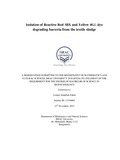| dc.contributor.advisor | Siddique, Ms. Romana | |
| dc.contributor.author | Fahim, Ahmed Abdullah | |
| dc.date.accessioned | 2016-01-18T12:44:10Z | |
| dc.date.available | 2016-01-18T12:44:10Z | |
| dc.date.copyright | 2015 | |
| dc.date.issued | 2015-11-23 | |
| dc.identifier.other | ID 11336004 | |
| dc.identifier.uri | http://hdl.handle.net/10361/4878 | |
| dc.description | This thesis report is submitted in partial fulfillment of the requirement for the degree of Bachelor of Science in Biotechnology, 2015. | en_US |
| dc.description | Cataloged from PDF version of thesis report. | |
| dc.description | Includes bibliographical references (page 78-87). | |
| dc.description.abstract | This world is getting polluted in different ways. This world has many prime components
including soil, water, and air. Every day to meet human needs thousands of mills, factories and
are producing necessary commodities. And they are polluting the environment in different
ways. Some factories are emitting poisonous gases, some are discharging effluents and liquid
waste in the environment which are creating hazardous problems in the water system and in
soil. And for this environment pollution one of the prime causes is discharging textile dyes
into the environment without treatment. This is a common problem for many countries as well
as for the Bangladesh. Textile dyes are chemical substances which can cause serious damages
to the nearby eco life. The treatment of the textile dyes after using in the factories is either
costly or time consuming. As a result mills and factories are not willing to do the treatment
process every time, rather they discharge it without any treatment. In this project textile dye
degrading bacteria were isolated from the textile sludge to degrade the textile dyes since this
biological process is less expensive than the other existing process. Two bacterial strain
Brevibacillus laterosporus and Staphylococcus nepalensis were isolated from the textile
sludge which was tested with two textile dyes; they are Yellow 4GL and Reactive Red 3BX.
And these both bacteria are very much effective to degrade these dyes. Especially
Brevibacillus laterosporus can de-color the Reactive Red 3BX dye in a very short time; even
the higher concentration of the dye can be degraded. | en_US |
| dc.description.statementofresponsibility | Ahmed Abdullah Fahim | |
| dc.format.extent | 91 pages | |
| dc.language.iso | en | en_US |
| dc.publisher | BRAC University | en_US |
| dc.rights | BRAC University thesis are protected by copyright. They may be viewed from this source for any purpose, but reproduction or distribution in any format is prohibited without written permission. | |
| dc.subject | Biotechnnology | en_US |
| dc.title | Isolation of reactive Red 3BX and Yellow 4GL dye degrading bacteria from the textile sludge | en_US |
| dc.type | Thesis | en_US |
| dc.contributor.department | Department of Mathematical and Natural Science, BRAC University | |
| dc.description.degree | B. Biotechnology | |

